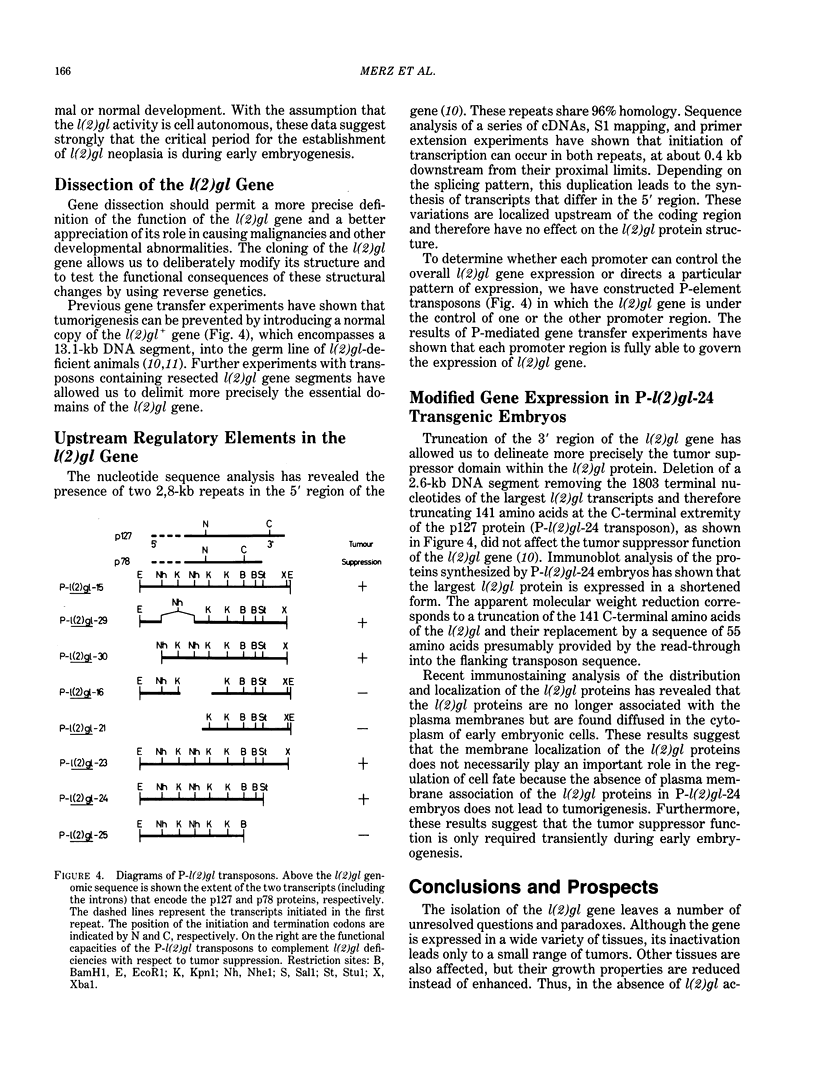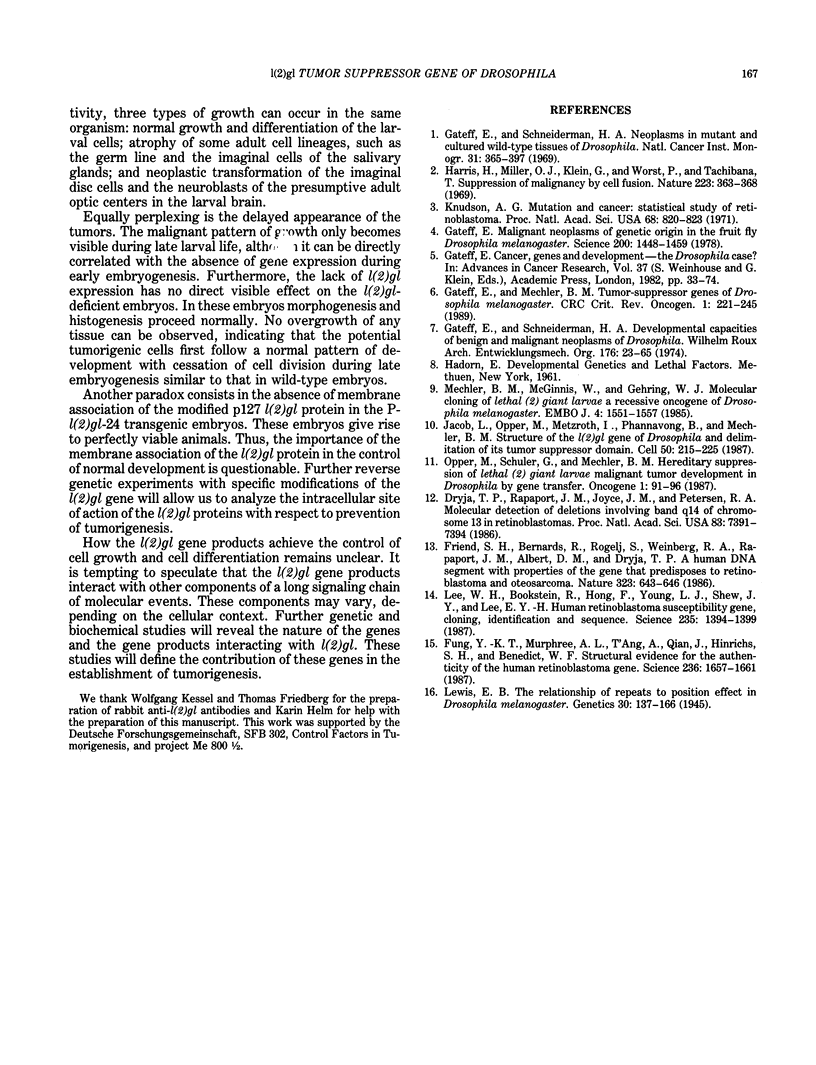Abstract
Tumor suppressor genes act as recessive determinants of cancer. These genes contribute to the normal phenotype and are required for regulating cell growth and differentiation during development. Inactivation of tumor suppressor genes leads to an unrestricted pattern of growth in specific cell types. In Drosophila, a series of genes have been identified that cause tissue-specific tumors after mutation. Of these, the lethal(2)giant larvae (l(2)gl) gene is the best studied. Homozygous l(2)gl mutations cause the development of malignant tumors in the brain and the imaginal discs. Genomic DNA from the l(2)gl locus has been cloned, introduced back into the genome of l(2)gl-deficient animals, and shown to reinstate normal development. The nucleotide sequence of the l(2)gl gene has been determined, as well as the sequences of two classes of transcripts. Analysis of the spatial distribution of both l(2)gl transcripts and proteins revealed that during early embryogenesis the l(2)gl gene is uniformly expressed in all cells and tissues. In late embryos, the l(2)gl expression becomes gradually restricted to tissues presenting no morphological or neoplastic alteration in the mutant animals. Further mosaic experiments revealed that l(2)gl gene loss can cause three distinct phenotypes: neoplastic transformation, abnormal differentiation, and normal development. These phenotypes depend upon the extent of gene activity in the stem cells prior to the formation of l(2)gl- clones. These analyses indicate that the critical period for the establishment of tumorigenesis occurs during early embryogenesis at a time when the l(2)gl expression is most intense in all cells.
Full text
PDF




Images in this article
Selected References
These references are in PubMed. This may not be the complete list of references from this article.
- Dryja T. P., Rapaport J. M., Joyce J. M., Petersen R. A. Molecular detection of deletions involving band q14 of chromosome 13 in retinoblastomas. Proc Natl Acad Sci U S A. 1986 Oct;83(19):7391–7394. doi: 10.1073/pnas.83.19.7391. [DOI] [PMC free article] [PubMed] [Google Scholar]
- Friend S. H., Bernards R., Rogelj S., Weinberg R. A., Rapaport J. M., Albert D. M., Dryja T. P. A human DNA segment with properties of the gene that predisposes to retinoblastoma and osteosarcoma. Nature. 1986 Oct 16;323(6089):643–646. doi: 10.1038/323643a0. [DOI] [PubMed] [Google Scholar]
- Fung Y. K., Murphree A. L., T'Ang A., Qian J., Hinrichs S. H., Benedict W. F. Structural evidence for the authenticity of the human retinoblastoma gene. Science. 1987 Jun 26;236(4809):1657–1661. doi: 10.1126/science.2885916. [DOI] [PubMed] [Google Scholar]
- Gateff E. Malignant neoplasms of genetic origin in Drosophila melanogaster. Science. 1978 Jun 30;200(4349):1448–1459. doi: 10.1126/science.96525. [DOI] [PubMed] [Google Scholar]
- Gateff E., Mechler B. M. Tumor-suppressor genes of Drosophila melanogaster. Crit Rev Oncog. 1989;1(2):221–245. [PubMed] [Google Scholar]
- Gateff E., Schneiderman H. A. Neoplasms in mutant and cultured wild-tupe tissues of Drosophila. Natl Cancer Inst Monogr. 1969 Jul;31:365–397. [PubMed] [Google Scholar]
- Harris H., Miller O. J., Klein G., Worst P., Tachibana T. Suppression of malignancy by cell fusion. Nature. 1969 Jul 26;223(5204):363–368. doi: 10.1038/223363a0. [DOI] [PubMed] [Google Scholar]
- Jacob L., Opper M., Metzroth B., Phannavong B., Mechler B. M. Structure of the l(2)gl gene of Drosophila and delimitation of its tumor suppressor domain. Cell. 1987 Jul 17;50(2):215–225. doi: 10.1016/0092-8674(87)90217-0. [DOI] [PubMed] [Google Scholar]
- Knudson A. G., Jr Mutation and cancer: statistical study of retinoblastoma. Proc Natl Acad Sci U S A. 1971 Apr;68(4):820–823. doi: 10.1073/pnas.68.4.820. [DOI] [PMC free article] [PubMed] [Google Scholar]
- Lee W. H., Bookstein R., Hong F., Young L. J., Shew J. Y., Lee E. Y. Human retinoblastoma susceptibility gene: cloning, identification, and sequence. Science. 1987 Mar 13;235(4794):1394–1399. doi: 10.1126/science.3823889. [DOI] [PubMed] [Google Scholar]
- Lewis E. B. The Relation of Repeats to Position Effect in Drosophila Melanogaster. Genetics. 1945 Mar;30(2):137–166. doi: 10.1093/genetics/30.2.137. [DOI] [PMC free article] [PubMed] [Google Scholar]
- Mechler B. M., McGinnis W., Gehring W. J. Molecular cloning of lethal(2)giant larvae, a recessive oncogene of Drosophila melanogaster. EMBO J. 1985 Jun;4(6):1551–1557. doi: 10.1002/j.1460-2075.1985.tb03816.x. [DOI] [PMC free article] [PubMed] [Google Scholar]
- Opper M., Schuler G., Mechler B. M. Hereditary suppression of lethal (2) giant larvae malignant tumor development in Drosophila by gene transfer. Oncogene. 1987 May;1(2):91–96. [PubMed] [Google Scholar]




